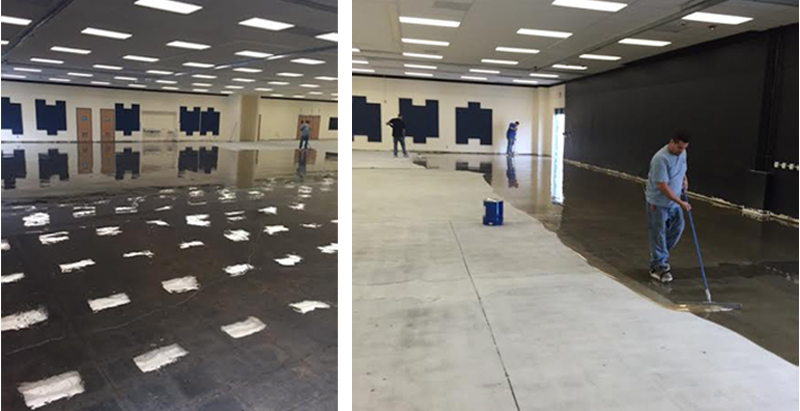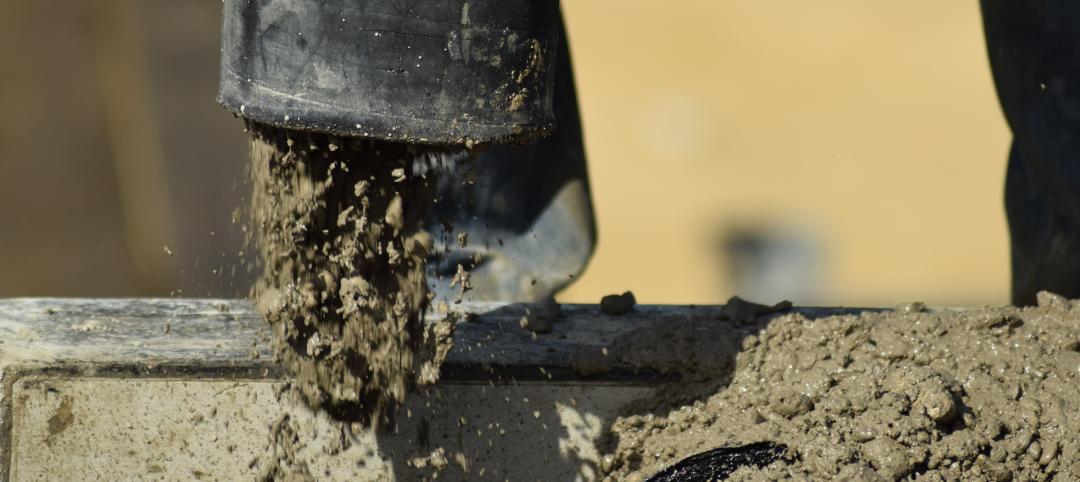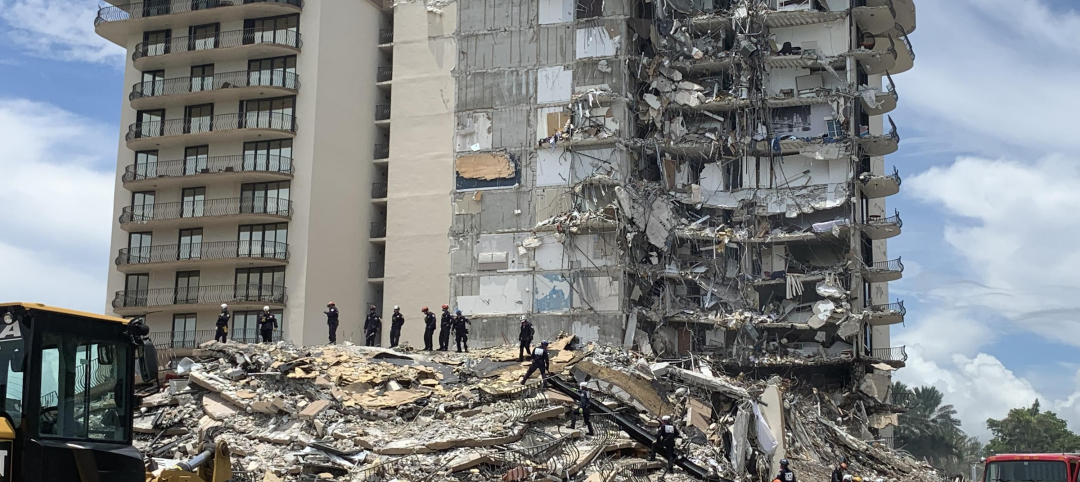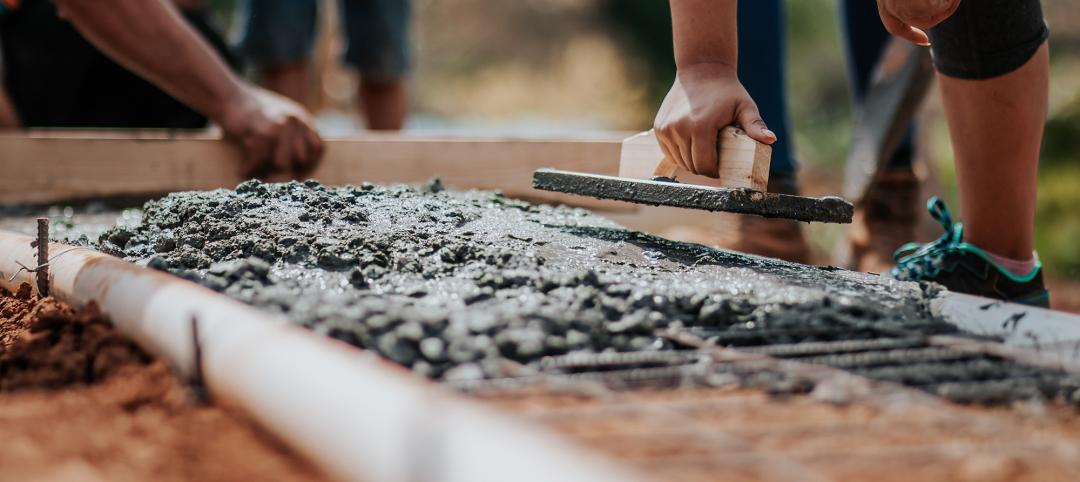When random tiles in South El Monte High School’s 11,300-sf “cafeteria-um” started popping up, the flooring started creating trip hazards. So department workers simply replaced the tiles. That didn’t work.
As the operations manager for Sunbelt Flooring in Chino, Calif., Chris Kelly has seen the moisture-beneath-the-surface tiling issue before. Working with CJ Knowland, a project engineer for Construct 1 in Tustin, Calif., Kelly assessed the damage. After 15 to 20 years of cleaning that floor, detergents and degreasers used by various cleaning crews seeped into the joints of the VCT soaking them, eventually creating a layer of contamination.
After testing the slab, they found the existing concrete slab had extremely high moisture levels. This moisture kept pushing the cafeteria-um’s VCT up, which caused tiles to pop. It created costly repairs and trip hazards, especially in one area, which Kelly mentioned had been repaired multiple times.
“I don’t think anybody knew that crack – as big as it was – was there,” Kelly says. “When you have a large, wide open structural crack, moisture takes the path of least resistance to the closest opening. They were having issues over the top of that crack. There was so much glue packed down there from times it had been repaired, it was hard to see until we shot-blasted the floor.”

After shot-blasting, they performed a water penetration test. “This helped assure that we get the proper penetration rate for our materials,” Kelly says. “No concrete is the same, so this is actually a very important step that we take.”
To ensure the slab would be free of moisture concerns, Sunbelt turned to AC Tech’s 2170, 100-percent reactive solids, tested to contain ZERO VOC emissions and almost no detectable odor, ideal for sensitive and soon-to-be-occupied areas.
Sunbelt removed all unsound concrete in the big structural crack, and then poured silica thickened AC Tech 2170 into the joints. They reinforced it with 2170 FC resin that was saturated into heavy mesh fiberglass. The 2170 and 2170 FC saturated in the woven fiberglass is used to displace the movement of the joints. Kelly stated, “If you don’t fill the joints with the AC Tech product itself, the moisture will find the joint and push out the filler, thus causing a failure. Standard epoxy is not designed to withstand what this slab had in moisture.”
Knowland said, “The AC Tech product was able to provide a 15-year warranty. It provided the solution to our moisture issues and the owner was very pleased with the end results.”
“Sunbelt is a reputable and professional flooring contractor,” says Dawn R. Parnoff, executive VP, AC Tech. “They don’t cut corners. We trust them; we never have to worry when they are on the job. It is the best-case scenario – the right company and right product equals success.”
South El Monte High School got its cafeteria-um back without the constant need to keep replacing tiles. “There is a bit of sticker shock when you need to make an investment like this, so it was a hard pill to swallow for the school district,” Kelly says. “That’s why it is so important to use right product.”
Related Stories
Great Solutions | Jul 23, 2024
41 Great Solutions for architects, engineers, and contractors
AI ChatBots, ambient computing, floating MRIs, low-carbon cement, sunshine on demand, next-generation top-down construction. These and 35 other innovations make up our 2024 Great Solutions Report, which highlights fresh ideas and innovations from leading architecture, engineering, and construction firms.
Concrete Technology | Jun 17, 2024
MIT researchers are working on a way to use concrete as an electric battery
Researchers at MIT have developed a concrete mixture that can store electrical energy. The researchers say the mixture of water, cement, and carbon black could be used for building foundations and street paving.
75 Top Building Products | Apr 22, 2024
Enter today! BD+C's 75 Top Building Products for 2024
BD+C editors are now accepting submissions for the annual 75 Top Building Products awards. The winners will be featured in the November/December 2024 issue of Building Design+Construction.
Sponsored | BD+C University Course | Jan 17, 2024
Waterproofing deep foundations for new construction
This continuing education course, by Walter P Moore's Amos Chan, P.E., BECxP, CxA+BE, covers design considerations for below-grade waterproofing for new construction, the types of below-grade systems available, and specific concerns associated with waterproofing deep foundations.
Concrete | Jan 12, 2024
Sustainable concrete reduces carbon emissions by at least 30%
Designed by Holcim, a building materials supplier, ECOPact offers a sustainable concrete alternative that not only meets, but exceeds the properties of standard concrete.
75 Top Building Products | Dec 13, 2023
75 top building products for 2023
From a bladeless rooftop wind energy system, to a troffer light fixture with built-in continuous visible light disinfection, innovation is plentiful in Building Design+Construction's annual 75 Top Products report.
Regulations | Oct 4, 2023
New York adopts emissions limits on concrete
New York State recently adopted emissions limits on concrete used for state-funded public building and transportation projects. It is the first state initiative in the U.S. to enact concrete emissions limits on projects undertaken by all agencies, according to a press release from the governor’s office.
Construction Costs | Sep 28, 2023
U.S. construction market moves toward building material price stabilization
The newly released Quarterly Construction Cost Insights Report for Q3 2023 from Gordian reveals material costs remain high compared to prior years, but there is a move towards price stabilization for building and construction materials after years of significant fluctuations. In this report, top industry experts from Gordian, as well as from Gilbane, McCarthy Building Companies, and DPR Construction weigh in on the overall trends seen for construction material costs, and offer innovative solutions to navigate this terrain.
Engineers | Sep 15, 2023
NIST investigation of Champlain Towers South collapse indicates no sinkhole
Investigators from the National Institute of Standards and Technology (NIST) say they have found no evidence of underground voids on the site of the Champlain Towers South collapse, according to a new NIST report. The team of investigators have studied the site’s subsurface conditions to determine if sinkholes or excessive settling of the pile foundations might have caused the collapse.
Concrete | Jul 19, 2023
Public policy hindering widespread adoption of sustainable concrete
Researchers are making significant strides in reducing embedded carbon in concrete, but public policies have been slow to adopt this more sustainable option.
















